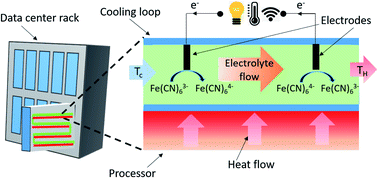Thermo-electrochemical generator: energy harvesting & thermoregulation for liquid cooling applications†
Abstract
Managing big data is a thermodynamics problem; decreasing size and increasing performance of electronic devices necessitate the use of liquid cooling to dissipate massive amounts of heat that are generated as a result. In locations such as data centers, CPU cooling is accomplished through the use of air and liquid methods. Currently, the purpose of existing liquid cooling designs is to provide cooling to these high power CPU's. We have tested and validated a modified liquid cooling design system that supplements the current cooling architecture with the ability to harvest energy from the waste-heat rejected from these heat sources. An electrolyte capable of undergoing a reversible redox reaction is pumped through a macro-channel flow thermo-electrochemical cell (fTEC). The heat energy flow is coupled with electrical energy through the thermoelectric effect allowing cooling and power harvesting to occur in parallel. Our current design generated 88 μW of power with a power density of 0.05 W m−2, achieved a heat transfer coefficient of 450 W (m2 K)−1. This technology can be employed in any location where liquid cooling is used, from CPU's in data centers to battery packs in electric vehicles. With a fTEC, heat mapping for the entire data center would be possible. This would improve thermoregulation and in addition the energy harvested will reduce the overhead cost for running a data center.



 Please wait while we load your content...
Please wait while we load your content...